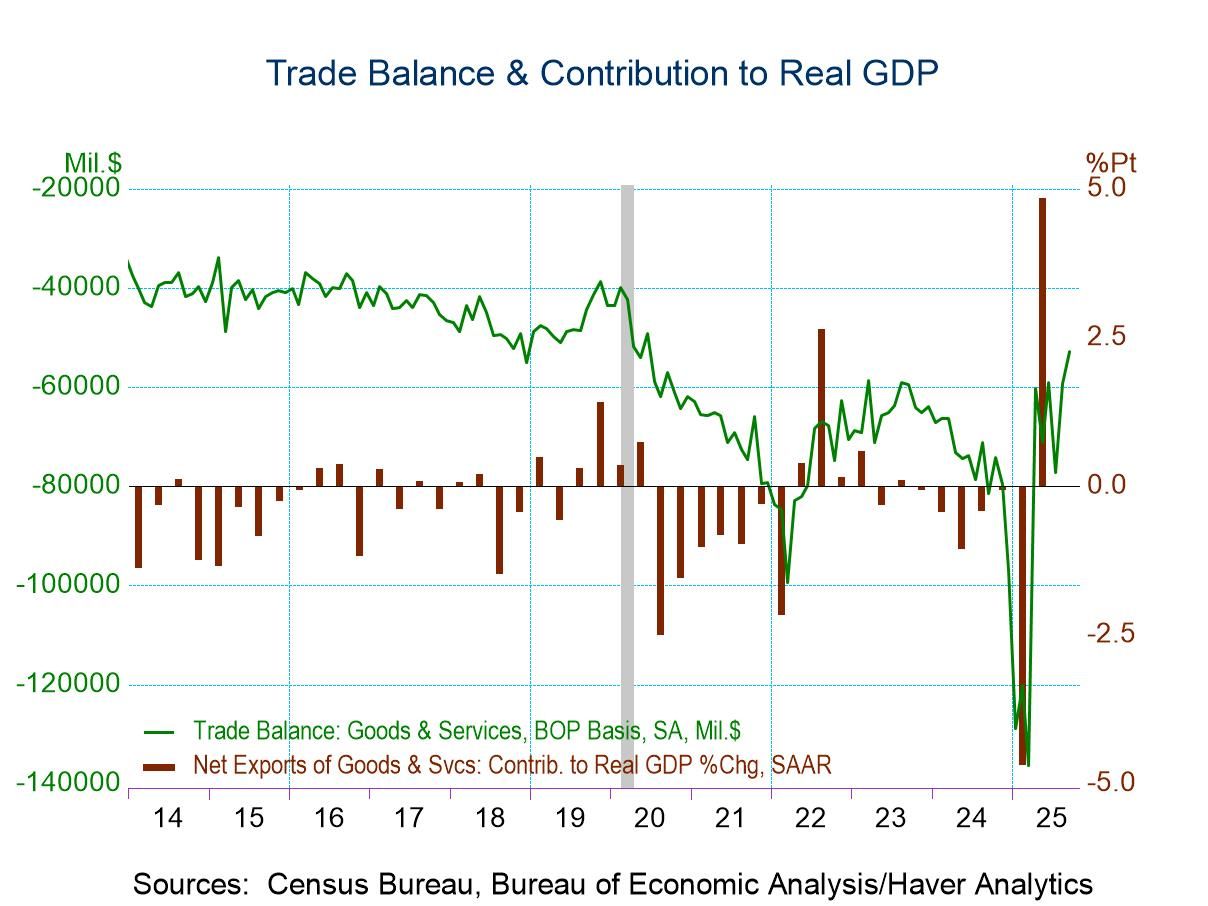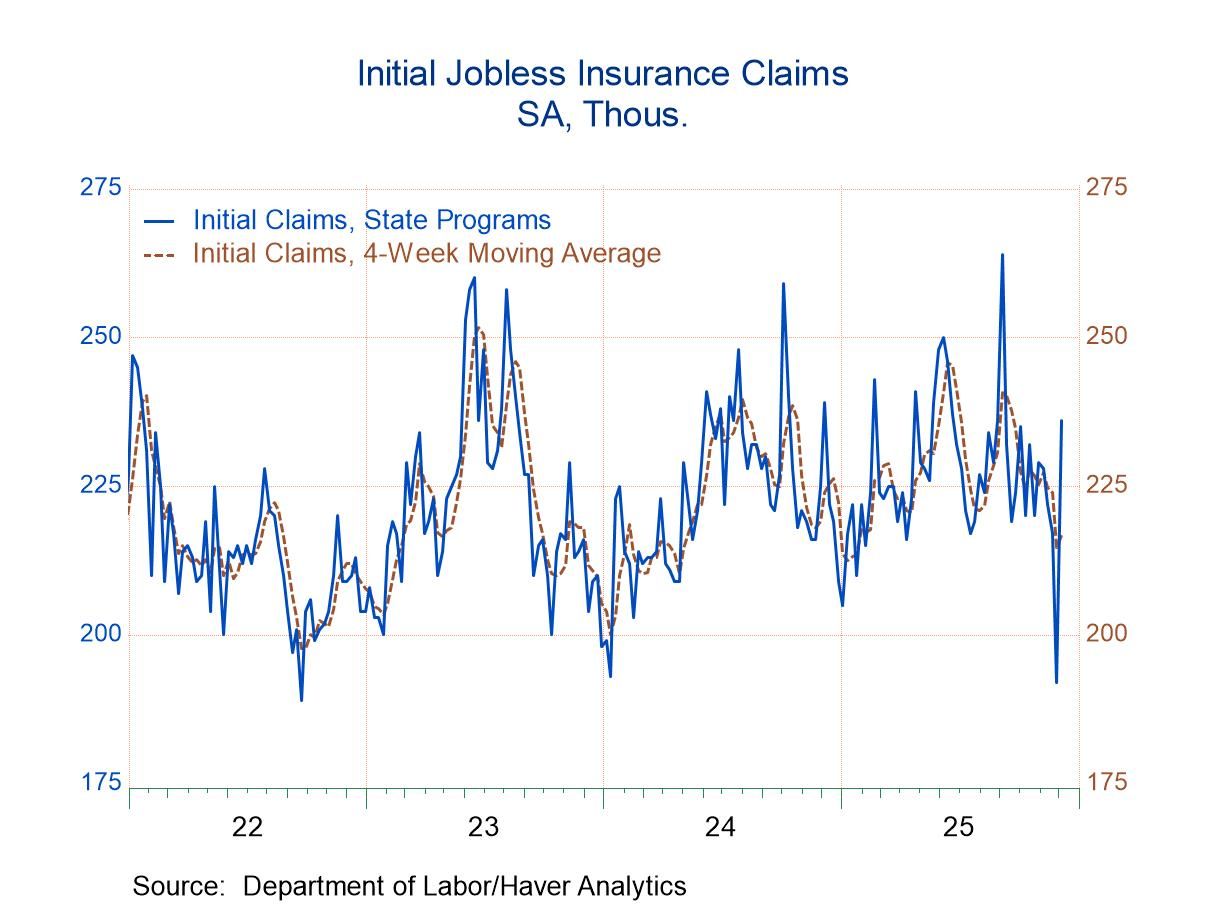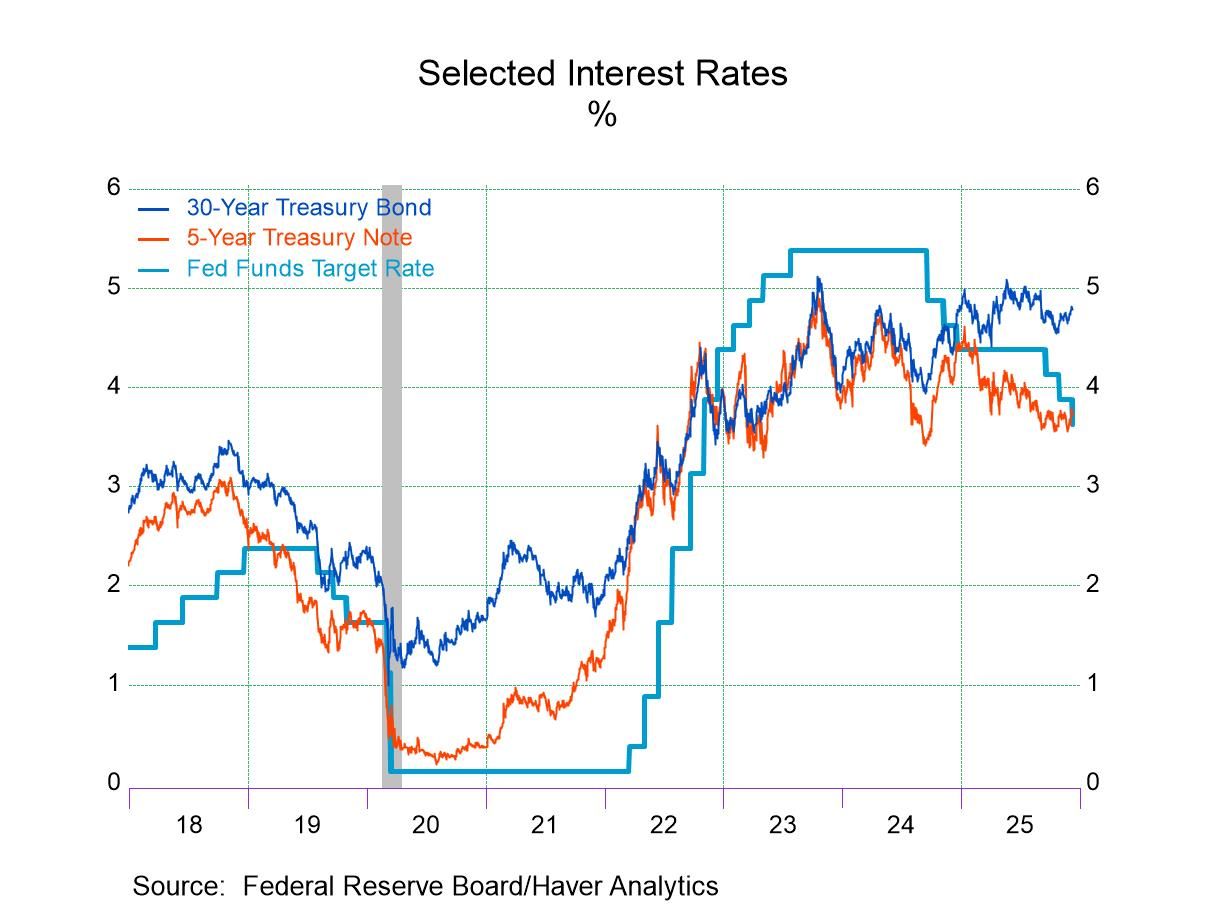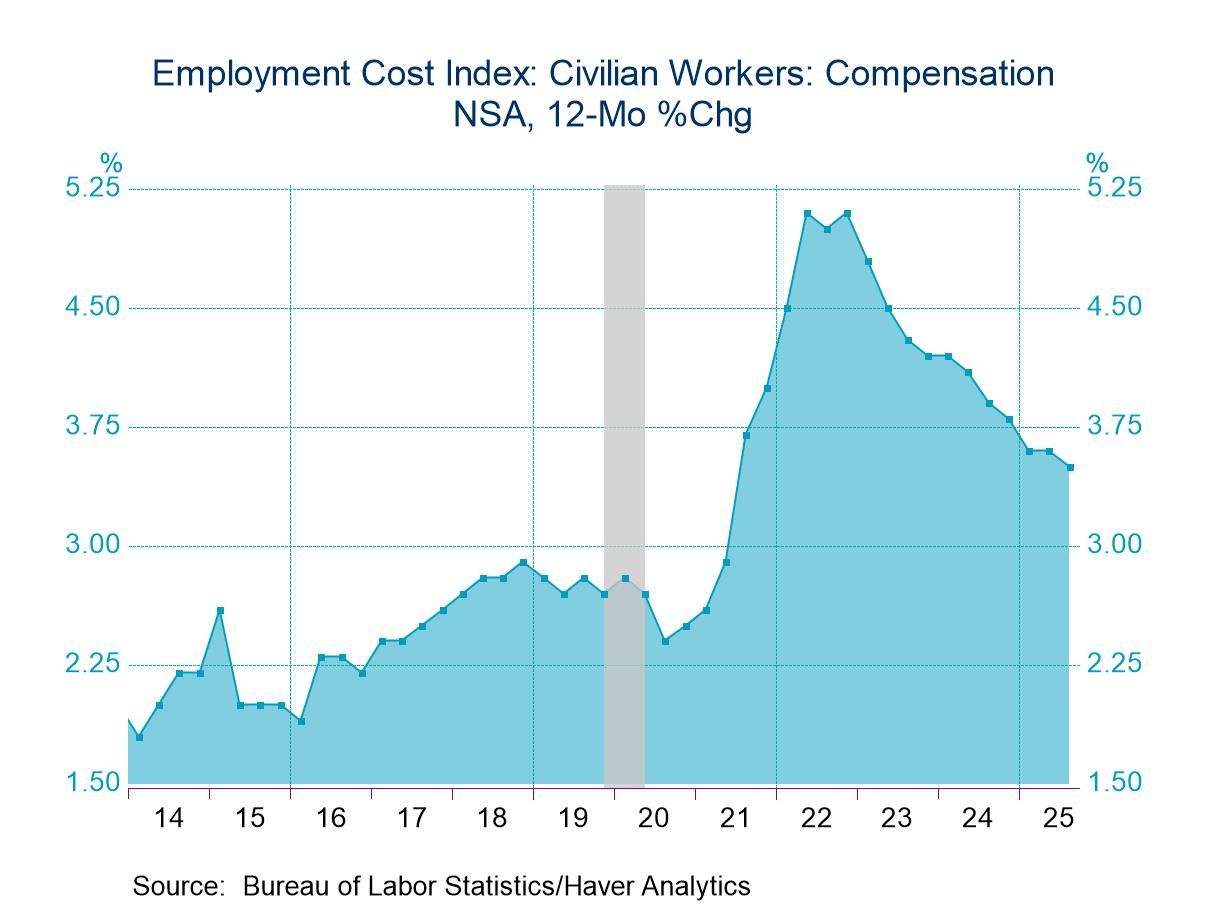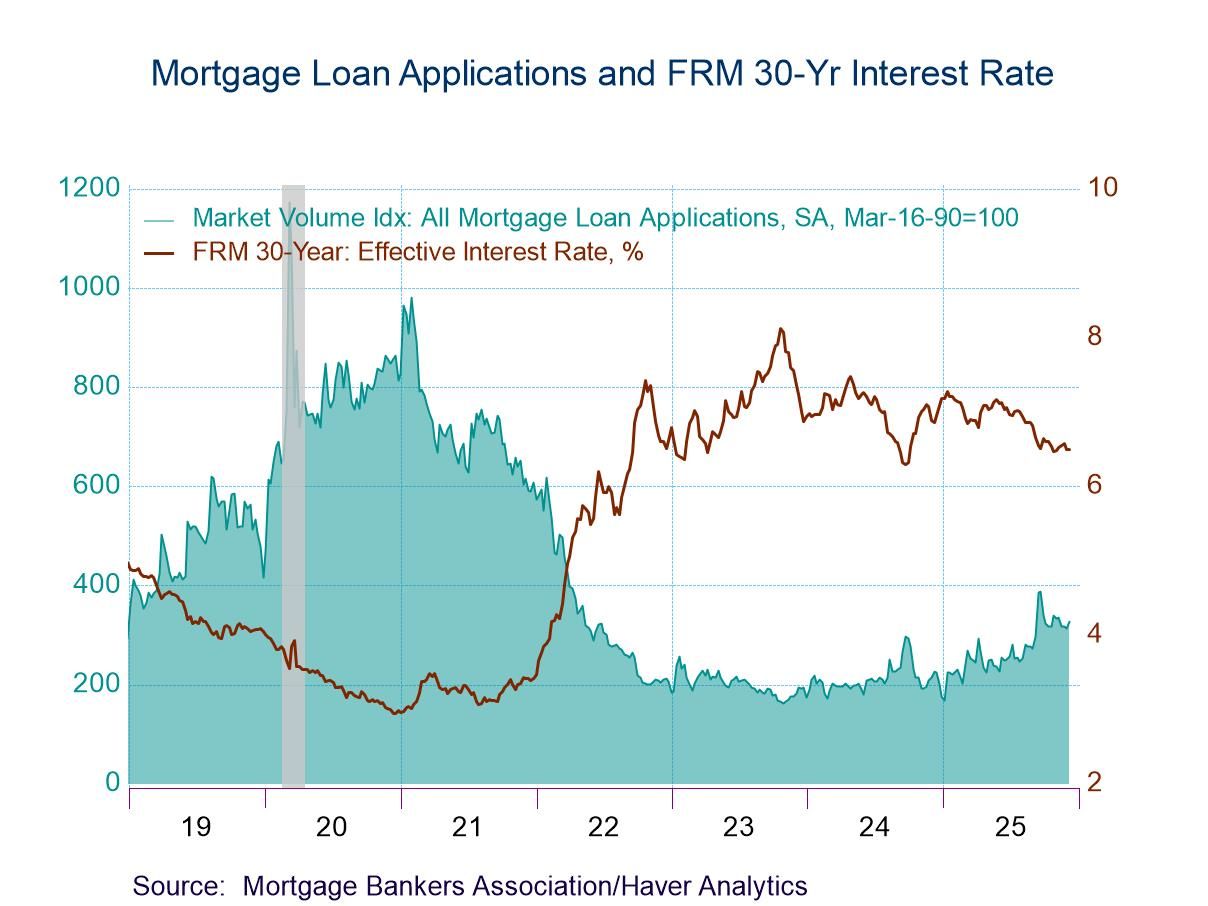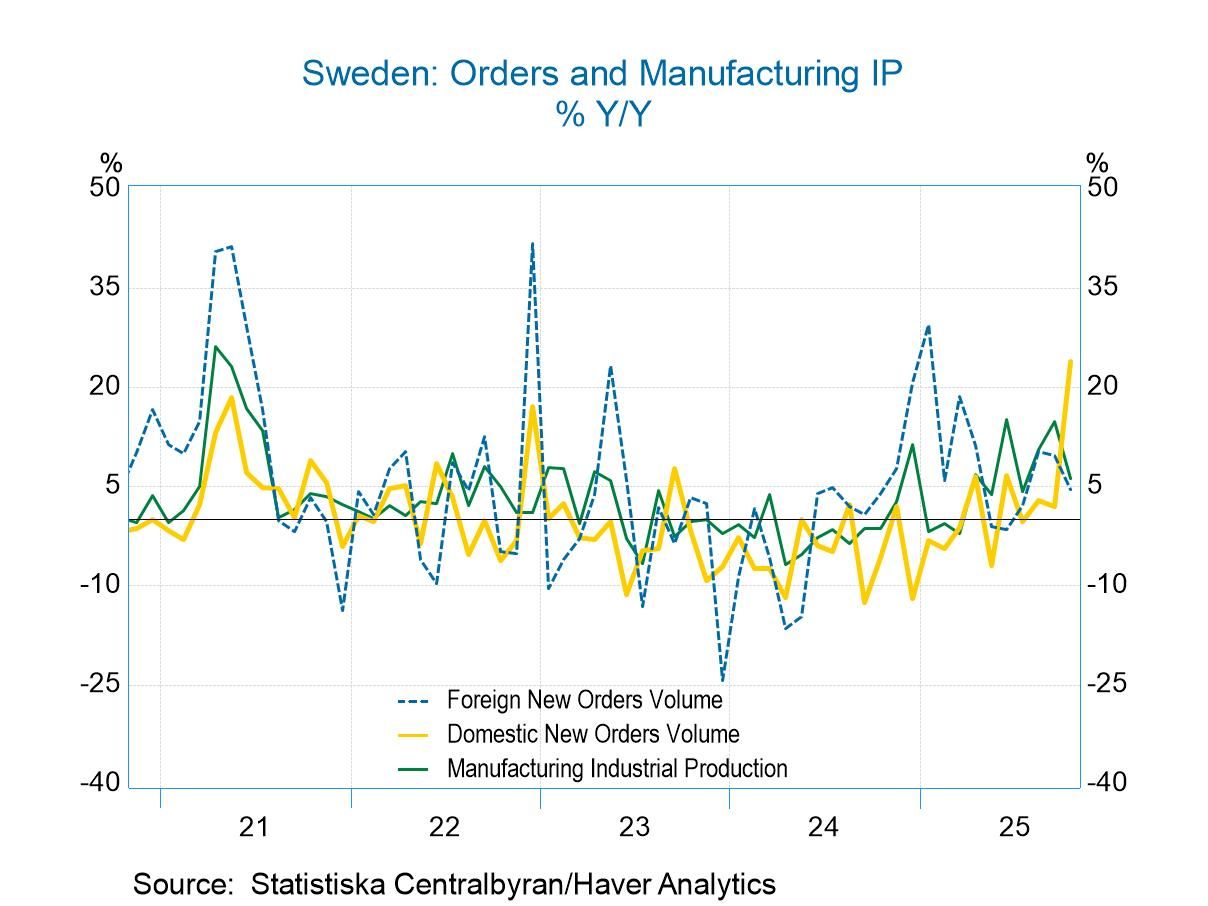- Foreign trade deficit shrinks to lowest since June 2020.
- Surge in exports is driven by foods, industrial supplies & nonauto consumer goods.
- Minimal import increase is held down by fewer capital goods, autos & foods.
- Services surplus eases.
- USA| Dec 11 2025
U.S. Trade Deficit Narrows to Five-Year Low in September
by:Tom Moeller
|in:Economy in Brief
Initial claims for unemployment insurance rose 44,000 to 236,000 during the week of December 6, after declining to 192,000 during the week of November 29, revised from 191,000. The four-week moving average of initial claims was 216,750, an increase of 2,000 from the previous week unrevised average of 214,750, which was the lowest level since January 2025.
Federal government employees initially filed 643 (NSA) jobless insurance claims in the week ended November 29, after 1,126 filed in the week ended November 22, revised from 1,125.
Continuing claims for unemployment insurance posted a sharp decline of 99,000 to 1,838,000 in the week ending November 29, from 1,937,000 the prior week, revised from 1.939 million. The four-week moving average decreased by 27,000 to 1,918,000 in the week ended November 29, from 1945,250 the prior week, revised from 1.945 million. The insured unemployment rate stood at 1.2% in the week of November 29, a decrease from 1.3% in the prior week.
Federal government employees continuing benefits fell to 12,732 (NSA) in the week ended November 22, from 17,862 in the week ended November 15, revised from 17,851.
The insured unemployment rate varied greatly across individual states and territories. In the week ended November 22, the highest unemployment rates were in New Jersey (2.18%), Washington (2.23%), Massachusetts (1.95%), Connecticut (1.83%) and Rhode Island (1.82%). The lowest rates were in Florida (0.27%), South Dakota (0.34%), North Carolina (0.39%), Louisiana (0.42%), Alabama (0.44%), Virginia and Tennessee (both 0.46%), and Arkansas and Nebraska (both 0.48%). Rates in other notable states include California (1.74%), New York (1.63%), Pennsylvania (1.46%), Illinois (1.45%), and Texas (1.07%). These state data are not seasonally adjusted.
Data on weekly unemployment claims are from the Department of Labor itself, not the Bureau of Labor Statistics. They begin in 1967 and are contained in Haver’s WEEKLY database and summarized monthly in USECON. Data for individual states are in REGIONW back to December 1986.
- Sweden| Dec 11 2025
The Curious Case of Swedish Inflation
Sweden’s inflation rate has developed into a very interesting oddity as headline inflation as measured by the harmonized index of consumer prices (HICP), that is used in Europe, has come to diverge sharply from the Swedish national rate of inflation measured by its national CPI. The HICP inflation rate is 2.2% over the last 12 months; Sweden’s national rate is up by only 0.2%. If we rank each of these two inflation rates on data back to 2001, the rank of the HICP is in its 72.2 percentile while the rank of the national CPI is in only its 19.4 percentile, the lower one-fifth of its historic range of national inflation rates. These two rankings occur over the same periods and so there's nothing about the periodicity that's responsible for this; there's simply very different performance over the recent span.
About measuring inflation The HICP was adopted in Europe once the monetary union was formed and the countries of Europe were not able to get together to decide how to treat housing costs, which are important element in the CPI. They had entered into CPIs in different countries in different ways at that point. In the United States, inflation statistics are often criticized because of the way the housing component fits into them. Housing has such a large weight in the U.S. inflation measure. U.S. housing costs consider the cost of running the house in terms of taxes and utility costs; they look at the rental equivalent values, and they also have an owner imputed rent for people who live in their own homes. Of course, owner equivalent rent is a made-up number; it's completely imputed. Because a lot of European mortgages are short-term and they reprice when the central bank changes its rate, it’s very important to be careful how interest rates are treated in the housing cost indexes in Europe. The central bank did not want to be in a position where it would be raising interest rates to fight inflation and causing inflation to be higher because they were raising the mortgage interest rates on homes and causing the cost of housing to go up. For this reason, the HICP measures do not include housing costs. As we can see in the Swedish details for this month, housing and fuel costs are down 3.1% year-over-year. If we look at the ranking of housing costs for year-over-year growth, we see that they rank in the lower 6.4 percentile and are one of the most important factors in driving the national CPI lower and, of course, that metric is absent from the HICP.
Inflation is always rife with controversy: All of this is simply just another way to point out that inflation, while we measure it and talk about it, it's a controversial subject. How we measure it does matter. However, for monetary policy purposes, if we construct a measure that is reasonable and if we follow it consistently over the years, it should give us good signals and a good way to measure inflation and engage monetary policy. Yet, very clearly, if there are two competing gauges, it could become a real problem to jump from one to the other because they track different circumstances.
The current state of Swedish inflation: Swedish inflation in November fell by 0.3% month-to-month after rising by 0.5% in October and falling by 0.1% in September. The diffusion, or breadth, of inflation acceleration was only 33.3% in November. It jumped up to 55.6% in October, but it had been lower in September at 33%. Looking at Swedish inflation over 12-month, 6-month, and 3-month periods, the HICP goes from 2.2% over 12 months to an annualized pace of 5.7% over 6 months and then back down to 0.5% over 3 months. The national CPI has the same sort of topography but different growth rates with the CPI up by only 0.2% over 12 months, accelerating to 1.5% over 6 months and then declining at a -0.9% annual rate over 3 months. Inflation diffusion over 3 months in the national index is only 11.1%, over 6 months it jumps up to 66.7%, and over 12 months it's at 44.4% which is below 50% marking inflation as having more deceleration than acceleration.
Controlled inflation: On balance, Swedish inflation appears to be under control using either method. The ranking for inflation by category shows high inflation for food & nonalcoholic beverages, education, other goods & services, and medical care. However, inflation is below its median pace and bears low rankings for clothing & footwear, housing, fuel & lighting, recreation & culture, and transportation. Inflation is always somewhat mixed across sectors. That’s another thing that makes it hard to pin down exactly what inflation is, because people who consume different baskets of goods are going to experience different inflation rates. However, Sweden appears to have its inflation situation under control whichever metric you look at. The chart makes it clear that after its spike during COVID, inflation has come back down to a reasonable long-term pace that appears to be close to something that the central bank would find acceptable. The recent rise in HICP inflation seems to be unwinding and year-over-pace is down to a moderate 2.2%.
- USA| Dec 10 2025
FOMC Lowers Fed Funds Rate Target as Expected
- Rate target lowered by quarter point for third time this year.
- The decision was mixed amongst FOMC voters.
by:Tom Moeller
|in:Economy in Brief
- USA| Dec 10 2025
U.S. Employment Cost Index Growth Eases in Q3’25
- Compensation continues to decelerate.
- Wage growth eases.
- Benefits increase edges up.
by:Tom Moeller
|in:Economy in Brief
- USA| Dec 10 2025
U.S. Mortgage Applications Jump in the Week of December 5
- Purchase applications fell 2.4% w/w; refinancing loan applications soared 14.3% w/w.
- Effective interest rate on 30-year fixed loans largely unchanged at 6.50%.
- Average loan size fell moderately.
- Sweden| Dec 10 2025
Sweden’s Industrial Production Falls in October
Swedish IP turns up sour in October: Industrial production in Sweden fell 5.7% in October, a relatively large decline, but it comes in a period when industrial production has been unusually volatile. Going back to July, industrial production fell month-to-month by 7.8%, then rose by 5.6% in August, rose again by 4.3% in September, and now fell by 5.7% in October. These month-to-month figures show a great deal of volatility in this series for industrial production excluding construction. The performance for overall manufacturing production is similarly volatile. The components in the table show that vehicle production, intermediate goods production, investment goods production, and the production of consumer nondurables all demonstrate the same kinds of monthly volatility.
Broader sequential growth rates settle down: Turning to sequential growth rates, conditions appeared to settle down to some extent, as industrial production excluding construction rises 6.6% over 12 months, at a slower of 5% annual rate over six months, then hops up to a 16.6% annual rate over three months. Manufacturing demonstrates the same growth slowdown and spurts over 12 months, six months, and three months. So does motor vehicle production, but with even greater extremes in the swings. The production of intermediate goods, on the other hand, shows steady acceleration. The investment goods sector shows growth over 12 months leading to a six-month slowdown and then a super spurt over three months that brings the growth rate to 50% annualized. Consumer nondurables output, on the other hand, shows a consistent slowdown from a 15.9% increase over 12 months to an 11.7% annual rate of increase over six months, to a decline of 1.7% at an annual rate over three months.
All are off their cycle peaks: All industrial production figures are well off of cycle peaks with motor vehicles the farthest off their cycle peak at just under 80% of their cycle peak, a standing similar for consumer nondurables. Overall industrial production excluding construction is only about 6 percentage points below its actual peak.
Quarter-to-date: The quarter to date industrial production excluding construction and the figure for overall manufacturing both showing annual rate declines between 7 and 10% at an annual rate. Motor vehicle production is making a modest recovery with a low single-digit growth rate. Intermediate goods are so far flat in the new quarter, with the investment goods output rising at a 22.1% annual rate and consumer nondurables output falling at a 37.2% annual rate. Once again, we see a great deal of volatility in these figures.
Current growth rate rankings over 24 years: However, taking an historic context, if we confine ourselves to looking at the year-over-year growth rates for Swedish industrial production, we find that overall production excluding construction has the growth rate with an 85.2 percentile standing. Manufacturing has an 84-percentile standing. Intermediate goods have a 71.5 percentile standing, with consumer nondurables having an 86-percentiles standing; investment goods have only a 63% standing. The production of motor vehicles has a 41.6% standing; it is the only category with a growth rate below its historic median.
Industrial order volumes The picture for order volume is volatility by month; however, on a sequential timeline from 12-months to six-months to three-months, order volume is accelerating. Domestic order volume is accelerating at an extremely rapid rate with orders at 23.8% year-over-year, a six-month growth rate of 43.9%, and a three-month growth rate of 116.4% annualized. Foreign orders also experience ongoing acceleration but to a much less extent, running from 4.5% over 12 months, to a 12.9% annual rate over six months, up to an 18.4% annualized pace over three months.
QTD and % of cycle highlights: Not surprisingly the orders growth rate is at a cycle high for domestic orders; the quarter-to-date total orders and domestic order growth are running at extremely strong rates. Foreign orders growth is at a negative 4.8% annualized for the first month in the new quarter.
Rankings: The ranking of the year-over-year growth rates finds total order volume at a 91.9% standing, domestic orders at a 99.3% standing, and foreign orders at a 62.1% standing, all of them above their historic medians by a wide margin.
Memo: Unemployment For comparison, we include the unemployment rate at the bottom of this table, and we see that Swedish unemployment continues to hover at an exceptionally high level. Ranked on data back to January 2021, the unemployment rate is at its top 2%. In fact, the October unemployment rate is the sixth highest monthly rate on this timeline. Despite what appears to be solid and even strong performance by the industrial sector, Swedish unemployment continues to linger at a level that is historically high for Sweden.
- USA| Dec 09 2025
U.S. JOLTS—Openings Rise Slightly; Hiring Declines in October
- Minimal rise in job openings follows sharp September increase.
- Sizable hiring decline reverses earlier increase.
- Separations fall sharply as quits plunge and layoffs rise.
by:Tom Moeller
|in:Economy in Brief
- of2684Go to 4 page


